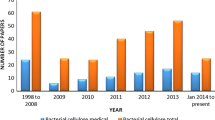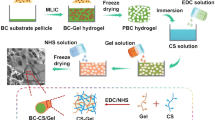Abstract
Bacterial cellulose (BC) has great potential for use as a tissue scaffold due to its unique structure and properties including high tensile strength and good biocompatibility. However, poor biodegradability of BC in the human body may be a key disadvantage limiting its application in the field. In this paper, we developed a simple absorption method to prepare biodegradable cellulase/BC materials. The morphology, structure, degradation ratio and mechanical properties during the degradation process were characterized and investigated. In vitro studies reveal that the BC material degraded gradually in simulated body fluid within 24 weeks and the degradation rate could be adjusted by modulating the cellulase content. The mechanical properties indicate the cellulase/BC material could maintain tensile strength for as long as 24 days during the degradation process. Muscle-derived cells were seeded on the cellulase/BC material to evaluate the cytotoxicity, using LIVE/DEAD® viability/cytotoxicity assay and H&E staining. In vivo biocompatibility was evaluated by subcutaneous implantation using a dog model for 1, 2, 3 and 4 weeks. These results demonstrate that the cellulase/BC material had good in vitro and in vivo biocompatibility.










Similar content being viewed by others
References
Alvarez O, Patel M, Booker J, Markowitz L (2004) Effectiveness of a biocellulose wound dressing for the treatment of chronic venous leg ulcers: results of a single center randomized study involving 24 patients. Wounds 16:224–233
Atala A (1997) Tissue engineering in the genitourinary system. Synthetic biodegradable polymer scaffolds. Birkhäuser, Boston, pp 149–164
Bäckdahl H, Helenius G, Bodin A, Nannmark U, Johansson BR, Risberg B, Gatenholm P (2006) Mechanical properties of bacterial cellulose and interactions with smooth muscle cells. Biomaterials 27:2141–2149
Bäckdahl H, Risberg B, Gatenholm P (2011) Observations on bacterial cellulose tube formation for application as vascular graft. Mater Sci Eng, C 31:14–21
Béguin P, Aubert JP (1994) The biological degradation of cellulose. FEMS Microbiol Rev 13:25–58
Bodin A, Bharadwaj S, Wu S, Gatenholm P, Atala A, Zhang Y (2010) Tissue-engineered conduit using urine-derived stem cells seeded bacterial cellulose polymer in urinary reconstruction and diversion. Biomaterials 31:8889–8901
Brown AJ (1886) XLIII. On an acetic ferment which forms cellulose. J Chem Soc, Faraday Trans 49:432–439
Catchmark JM, Fugmann B, Hu Y (2010) Degradable biomolecule compositions. Google patents, US 2010/0172889 A1
Czaja W, Kyryliouk D, DePaula CA, Buechter DD (2014) Oxidation of γ-irradiated microbial cellulose results in bioresorbable, highly conformable biomaterial. J Appl Polym Sci 131:39995–40006
Endo K, Hakamada Y, Takizawa S, Kubota H, Sumitomo N, Kobayashi T, Ito S (2001) A novel alkaline endoglucanase from an alkaliphilic Bacillus isolate: enzymatic properties, and nucleotide and deduced amino acid sequences. Appl Microbiol Biotechnol 57:109–116
Gusakov AV, Salanovich TN, Antonov AI, Ustinov BB, Okunev ON, Burlingame R, Emalfarb M, Baez M, Sinitsyn AP (2007) Design of highly efficient cellulase mixtures for enzymatic hydrolysis of cellulose. Biotechnol Bioeng 97:1028–1038
Helenius G, Bäckdahl H, Bodin A, Nannmark U, Gatenholm P, Risberg B (2006) In vivo biocompatibility of bacterial cellulose. J Biomed Mater Res A 76:431–438
Hu Y, Catchmark JM (2011a) In vitro biodegradability and mechanical properties of bioabsorbable bacterial cellulose incorporating cellulases. Acta Biomater 7:2835–2845
Hu Y, Catchmark JM (2011b) Integration of cellulases into bacterial cellulose: toward bioabsorbable cellulose composites. J Biomed Mater Res B 97:114–123
Hu W, Liu S, Chen S, Wang H (2011) Preparation and properties of photochromic bacterial cellulose nanofibrous membranes. Cellulose 18:655–661
Huang Y, Zhu C, Yang J, Nie Y, Chen C, Sun D (2014) Recent advances in bacterial cellulose. Cellulose 21:1–30
Jeffries T, Eveleigh D, Macmillan J, Parrish F, Reese E (1977) Enzymatic hydrolysis of the walls of yeasts cells and germinated fungal spores. BBA Gen Subj 499:10–23
Klemm D, Schumann D, Udhardt U, Marsch S (2001) Bacterial synthesized cellulose-artificial blood vessels for microsurgery. Prog Polym Sci 26:1561–1603
Kokubo T, Takadama H (2006) How useful is SBF in predicting in vivo bone bioactivity? Biomaterials 27:2907–2915
Kokubo T, Kushitani H, Sakka S, Kitsugi T, Yamamuro T (1990) Solutions able to reproduce in vivo surface-structure changes in bioactive glass-ceramic A-W3. J Biomed Mater Res 24:721–734
Li J, Wan Y, Li L, Liang H, Wang J (2009) Preparation and characterization of 2,3-dialdehyde bacterial cellulose for potential biodegradable tissue engineering scaffolds. Mater Sci Eng, C 29:1635–1642
Li Z, Wang L, Chen S, Feng C, Chen S, Yin N, Yang J, Wang H, Xu Y (2015) Facilely green synthesis of silver nanoparticles into bacterial cellulose. Cellulose 22:373–383
Liu S-L, Chen W-Z, Wang Y, Liu G, Yu S-W, Xing M (2008) Purification and characterization of a novel neutral β-glucanase and an alkaline β-glucanase from an alkaliphilic Bacillus isolate. World J Microbiol Biotechnol 24:149–155
Maurel W, Thalmann D, Wu Y, Thalmann NM (1998) Constitutive modeling. Biomechanical models for soft tissue simulation. Springer, Berlin, pp 79–120
Mergenthaler P, Lindauer U, Dienel GA, Meisel A (2013) Sugar for the brain: the role of glucose in physiological and pathological brain function. Trends Neurosci 36:587–597
Müller D, Rambo C, Recouvreux D, Porto L, Barra G (2011) Chemical in situ polymerization of polypyrrole on bacterial cellulose nanofibers. Synth Met 161:106–111
Nakanishi Y, Chen G, Komuro H, Ushida T, Kaneko S, Tateishi T, Kaneko M (2003) Tissue-engineered urinary bladder wall sing PLGA mesh-collagen hybrid scaffolds: a comparison study of collagen sponge and gel as a caffold. J Pediatr Surg 38:1781–1784
Ni J, Wang M (2002) In vitro evaluation of hydroxyapatite reinforced polyhydroxybutyrate composite. Mater Sci Eng, C 20:101–109
Park S, Baker JO, Himmel ME, Parilla PA, Johnson DK (2010) Cellulose crystallinity index: measurement techniques and their impact on interpreting cellulase performance. Biotechnol Biofuels 3:1
Peng S, Zheng Y, Wu J, Wu Y, Ma Y, Song W, Xi T (2012) Preparation and characterization of degradable oxidized bacterial cellulose reacted with nitrogen dioxide. Polym Bull 68:415–423
Pértile RA, Moreira S, Gil da Costa RM, Correia A, Guãrdao L, Gartner F, Vilanova M, Gama M (2012) Bacterial cellulose: long-term biocompatibility studies. J Biomater Sci Polym Ed 23:1339–1354
Petersen N, Gatenholm P (2011) Bacterial cellulose-based materials and medical devices: current state and perspectives. Appl Microbiol Biotechnol 91:1277–1286
Schumann DA, Wippermann J, Klemm DO, Kramer F, Koth D, Kosmehl H, Wahlers T, Salehi-Gelani S (2009) Artificial vascular implants from bacterial cellulose: preliminary results of small arterial substitutes. Cellulose 16:877–885
Scrivener A, Zhao L, Slaytor M (1997) Biochemical and immunological relationships between endo-β-1, 4-glucanases from cockroaches. Comp Biochem Physiol B: Biochem Mol Biol 118:837–843
Svensson A, Nicklasson E, Harrah T, Panilaitis B, Kaplan D, Brittberg M, Gatenholm P (2005) Bacterial cellulose as a potential scaffold for tissue engineering of cartilage. Biomaterials 26:419–431
Tanaka T, Takahashi M, Nitta N, Furukawa A, Andoh A, Saito Y, Fujiyama Y, Murata K (2006) Newly developed biodegradable stents for benign gastrointestinal tract stenoses: a preliminary clinical trial. Digestion 74:199–205
Vitta S, Drillon M, Derory A (2010) Magnetically responsive bacterial cellulose: synthesis and magnetic studies. J Appl Phys 108:053905
Walker L, Wilson D (1991) Enzymatic hydrolysis of cellulose: an overview. Bioresour Technol 36:3–14
Wang J, Zhu Y, Du J (2011) Bacterial cellulose: a natural nanomaterial for biomedical applications. J Mech Med Biol 11:285–306
Watanabe K, Tabuchi M, Morinaga Y, Yoshinaga F (1998) Structural features and properties of bacterial cellulose produced in agitated culture. Cellulose 5:187–200
Yang J, Lv X, Chen S, Li Z, Feng C, Wang H, Xu Y (2014) In situ fabrication of a microporous bacterial cellulose/potato starch composite scaffold with enhanced cell compatibility. Cellulose 21:1823–1835
Yin N, Stilwell MD, Santos TM, Wang H, Weibel DB (2015) Agarose particle-templated porous bacterial cellulose and its application in cartilage growth in vitro. Acta Biomater 12:129–138
Yu L, Lin J, Tian F, Li X, Bian F, Wang J (2014) Cellulose nanofibrils generated from jute fibers with tunable polymorphs and crystallinity. J Mater Chem A 2:6402–6411
Acknowledgments
This work was financially supported by the National Natural Science Foundation of China (51273043, 51573024 and 81370795), the Fundamental Research Funds for the Central Universities and DHU Distinguished Young Professor Program.
Author information
Authors and Affiliations
Corresponding authors
Ethics declarations
All applicable international, national, and/or institutional guidelines for the care and use of animals were followed.
Additional information
Baoxiu Wang and Xiangguo Lv have contributed equally to this work and also co-first authors.
Electronic supplementary material
Below is the link to the electronic supplementary material.
Rights and permissions
About this article
Cite this article
Wang, B., Lv, X., Chen, S. et al. In vitro biodegradability of bacterial cellulose by cellulase in simulated body fluid and compatibility in vivo. Cellulose 23, 3187–3198 (2016). https://doi.org/10.1007/s10570-016-0993-z
Received:
Accepted:
Published:
Issue Date:
DOI: https://doi.org/10.1007/s10570-016-0993-z




